Basenji
The Basenji is a breed of hunting dog. It was bred from stock that originated in central Africa. Most of the major kennel clubs in the English-speaking world place the breed in the hound group, specifically in the sighthound type. The Fédération Cynologique Internationale places the breed in its group five, and the United Kennel Club places the breed in its Sighthound and pariah group.
| Basenji | |||||||||||||||||||||||||
|---|---|---|---|---|---|---|---|---|---|---|---|---|---|---|---|---|---|---|---|---|---|---|---|---|---|
.jpg) A red Basenji with white markings | |||||||||||||||||||||||||
| Other names |
| ||||||||||||||||||||||||
| Origin | Democratic Republic of the Congo | ||||||||||||||||||||||||
| |||||||||||||||||||||||||
| |||||||||||||||||||||||||
| Dog (domestic dog) | |||||||||||||||||||||||||
The Basenji produces an unusual yodel-like sound, due to its unusually shaped larynx.[1] This trait also gives the Basenji the nickname barkless dog.[2]
Basenjis share many unique traits with pariah dog types. Basenjis, like dingoes, New Guinea singing dogs and some other breeds of dog such as Tibetan mastiffs, come into estrus only once annually, as compared to other dog breeds, which may have two or more breeding seasons every year. Both dingoes and Basenji lack a distinctive odor,[3] and are prone to howls, yodels, and other vocalizations over the characteristic bark of modern dog breeds.[4] One theory holds that the latter trait is the result of selecting against dogs that frequently bark, because barking could lead enemies to humans' forest encampments. While dogs that resemble the Basenji in some respects are commonplace over much of Africa, the breed's original foundation stock came from the old growth forest regions of the Congo Basin, where its structure and type were fixed by adaptation to its habitat, as well as use.
Lineage
The Basenji has been identified as a basal breed that predates the emergence of the modern breeds in the 19th century.[5] Recent DNA studies based on whole-genome sequences indicate that the domestic dog is a genetically divergent subspecies of the gray wolf and was derived from a now-extinct ghost population of Late Pleistocene wolves, and the basenji and the dingo are both considered to be basal members of the domestic dog clade.[6][7][8]
Name
The Azande and Mangbetu people from the northeastern Congo region describe Basenjis, in the local Lingala language, as mbwá na basɛ́nzi. Translated, this means 'dogs of the savages', or 'dogs of the villagers'. In the Congo, the Basenji is also known as "dog of the bush". The dogs are also known to the Azande of southern Sudan as ango angari.[9] The word basɛ́nzi itself is the plural form of mosɛ́nzi. In Swahili, another Bantu language, from East Africa, mbwa shenzi translates to 'wild dog'. Another local name is m’bwa m’kube m’bwa wamwitu, or 'dog that jumps up and down',[10] a reference to their tendency to jump straight up to spot their quarry.
History
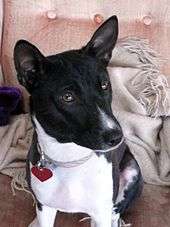
Originating on the continent of Africa,[11] basenji-like dogs are depicted in drawings and models dating back to the Twelfth Dynasty of Egypt.[12] Dogs of this type were originally kept for hunting small game by tracking and driving the game into nets.[2][12]
Europeans first described the type of dog the Basenji breed derives from in 1895—in the Congo. These local dogs, which Europeans identified as a unique breed and called basenji, were prized by locals for their intelligence, courage, speed, and silence. An article published called The Intelligence of Dogs by Stanley Coren, PhD questions this. It ranks the breed at #78 out of 79, which is the second to lowest rank in intelligence. Some consider this an unreliable list, as it focuses on only the ability to listen to a first command. Some consider independent dogs such as Basenjis and Afghan Hounds more intelligent than obedient breeds because of their ability to recognize which actions benefit them, and which simply please another.[13]
Several attempts were made to bring the breed to England, but the earliest imports succumbed to disease. In 1923, for example, Lady Helen Nutting brought six Basenjis with her from Sudan, but all six died from distemper shots they received in quarantine.[14] It was not until the 1930s that foundation stock was successfully established in England, and then to the United States by animal importer Henry Trefflich. It is likely that nearly all the Basenjis in the Western world are descended from these few original imports.[15] The breed was officially accepted into the AKC in 1943. In 1990, the AKC stud book was reopened to 14 new imports at the request of the Basenji Club of America.[16] The stud book was reopened again to selected imported dogs from 1 January 2009 to 31 December 2013.[17] An American-led expedition collected breeding stock in villages in the Basankusu area of the Democratic Republic of Congo, in 2010.[18] Basenjis are also registered with the United Kennel Club.
The popularity of the Basenji in the United States, according to the American Kennel Club, has declined over the past decade, with the breed ranked 71st in 1999, decreasing to 84th in 2006, and to 93rd in 2011.[19]
Characteristics
Appearance
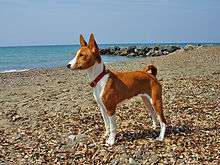
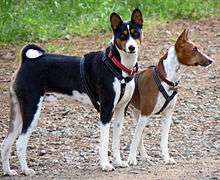
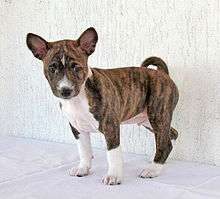
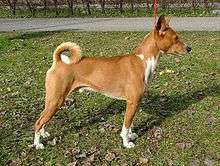
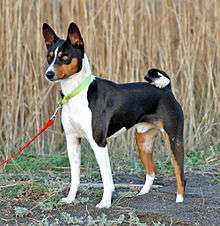
Basenjis are small, short-haired dogs with erect ears, tightly curled tails and graceful necks. A Basenji's forehead is wrinkled, even more so when they are young or extremely excited. A Basenji's eyes are typically almond-shaped. Basenjis typically weigh about 9.1–10.9 kg (20–24 lb)[20] and stand 41–46 cm (16–18 in)[21] at the shoulder. They are a square breed, which means they are as long as they are tall with males usually larger than females. Basenjis are athletic dogs, and deceptively powerful for their size. They have a graceful, confident gait like a trotting horse, and skim the ground in a double suspension gallop, with their characteristic curled tail straightened out for greater balance when running at their top speed. Basenjis come in a few different colorations: red, black, tricolor, and brindle, and they all have white feet, chests and tail tips. They can also come in trindle, which is a tricolor with brindle points, a rare combination.
Temperament and behavior
The Basenji is alert, energetic, curious and reserved with strangers. The Basenji tends to become emotionally attached to a single human. Basenjis may not get along with non-canine pets. Basenjis dislike wet weather, much like cats, and will often refuse to go outside in any sort of damp conditions. They like to climb, and can easily scale chain wire/link fences.
Basenjis often stand on their hind legs, somewhat like a meerkat, by themselves or leaning on something; this behavior is often observed when the dog is curious about something. Basenjis have a strong prey drive. According to the book The Intelligence of Dogs, they are the second least trainable dog, when required to do human commands (behind only the Afghan Hound). Their real intelligence manifests, when they are required to actually "think".
Basenjis are highly prey driven and will go after cats and other small animals.
Health
There is only one completed health survey of dog breeds, including the Basenji, that was conducted by the UK Kennel Club in 2004. The survey indicated the prevalence of diseases in Basenjis with dermatitis (9% of responses), incontinence and bladder infection (5%), hypothyroidism (4%), pyometra and infertility (4%).[22]
Longevity
Basenjis in the 2004 UK Kennel Club survey had a median lifespan of 13.6 years (sample size of 46 deceased dogs),[22] which is 1–2 years longer than the median lifespan of other breeds of similar size.[23] The oldest dog in the survey was 17.5 years. The most common causes of death were old age (30%), urologic (incontinence, Fanconi syndrome, chronic kidney failure 13%), behavior ("unspecified" and aggression 9%), and cancer (9%).[22]
Fanconi syndrome
Fanconi syndrome, an inheritable disorder in which the renal (kidney) tubes fail to reabsorb electrolytes and nutrients,[24] is unusually common in Basenjis.[25] Symptoms include excessive drinking, excessive urination, and glucose in the urine, which may lead to a misdiagnosis of diabetes. Fanconi syndrome usually presents between 4 and 8 years of age, but sometimes as early as 3 years or as late as 10 years. Fanconi syndrome is treatable and organ damage is reduced if treatment begins early. Basenji owners are advised to test their dog's urine for glucose once a month beginning at the age of 3 years. Glucose testing strips designed for human diabetics are inexpensive and available at most pharmacies. A Fanconi disease management protocol has been developed that can be used by veterinarians to treat Fanconi-afflicted dogs.[26]
Fanconi DNA linkage test
In 2007, the first linked marker DNA test was released for predicting Fanconi syndrome in Basenjis.[27] With this test, it is possible to more accurately determine the probability of a dog's carrying the gene for Fanconi syndrome.
Dogs tested using this "linkage test" return one of the following statuses:
- Probably clear/normal
- Indicates the individual has most likely inherited normal DNA from both parents. It is unlikely that Basenjis that test this way will produce affected puppies, no matter which dog they breed with.
- Probably carrier
- Indicates the individual has most likely inherited normal DNA from one parent and DNA with the Fanconi syndrome mutation from the other parent. This basenji is unlikely to develop Fanconi syndrome, but could produce puppies that do. To minimize the chances of this happening, it is recommended carriers be bred only to those that test as Probably clear/Normal for Fanconi syndrome.
- Probably equivocal/indeterminate
- Indicates the individual's DNA contained features found in both "normal" and "carrier" Basenjis. At present it cannot be predicted whether these Basenjis are carriers or normal; however, it is unlikely that they will develop Fanconi syndrome. The safest strategy would be to treat them as "carriers" and bred to only those Basenjis that test as Probably Clear/Normal for Fanconi syndrome.
- Probably affected
- Indicates the individual is likely to develop clinical Fanconi syndrome and is likely to produce puppies with Fanconi syndrome if bred to Basenjis other than those that test as Probably Clear/Normal for Fanconi syndrome.
This linkage test is being provided as a tool to assist breeders whilst research continues towards the development of the direct Fanconi test.
Other Basenji health issues
Basenjis sometimes carry a simple recessive gene that, when homozygous for the defect, causes genetic hemolytic anemia.[28] Most 21st-century Basenjis are descended from ancestors that have tested clean. When lineage from a fully tested line (set of ancestors) cannot be completely verified, the dog should be tested before breeding. As this is a non-invasive DNA test, a Basenji can be tested for HA at any time.
Basenjis sometimes suffer from hip dysplasia, resulting in loss of mobility and arthritis-like symptoms. All dogs should be tested by either OFA or PennHIP prior to breeding.
Malabsorption, or immunoproliferative enteropathy, is an autoimmune intestinal disease that leads to anorexia, chronic diarrhea, and even death. A special diet can improve the quality of life for afflicted dogs.
The breed can also fall victim to progressive retinal atrophy (a degeneration of the retina causing blindness) and several less serious hereditary eye problems such as coloboma (a hole in the eye structure), and persistent pupillary membrane (tiny threads across the pupil).
- Basenji
- Tri-Colored Basenji
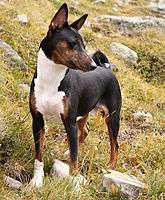 Trindle Basenji
Trindle Basenji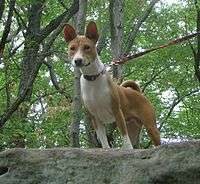 Basenji showing characteristic, forward-pointing ears.
Basenji showing characteristic, forward-pointing ears.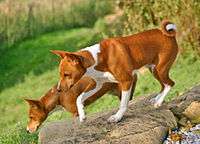 A pair of red Basenjis
A pair of red Basenjis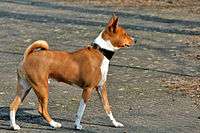 Side profile of a red and white Basenji
Side profile of a red and white Basenji
In popular culture
- The title character of the 1954 novel Good-bye, My Lady, by James H. Street, is a Basenji (female). The book was made into a film of the same name in 1956, with a cast that included Brandon deWilde, Walter Brennan, and Sidney Poitier.[29] Several Basenjis were used in the lead role, the main "star" being "My Lady of the Congo" a six-month old Basenji bred by Veronica Tudor-Williams of Molesey, England. She was followed by four other young Basenjis to act as doubles including her sibling, "My Lord of the Congo", and "Flageolet of the Congo", (who would become an International Champion). "My Lady" did most of the scenes.[30]
- The true story of a Basenji was featured in the episode "The Cat Came Back" on the radio program This American Life.[31]
- According to the webcomic Achewood, if Jesus Christ were a dog, he would be a Basenji.[32]
- Basenjis are featured in the fourth episode, "Tyler Tucker, I Presume?", of the third season of the animated television series The Wild Thornberrys. Nigel Thornberry encounters a group of tribesmen along with their Congolese hunting dogs. The series's director, Mark Risley, owns several Basenjis, and his dogs provided the recorded voices for their animated counterparts.
- An episode of Pound Puppies, "The Pups Who Loved Me", revolves around a Basenji secret agent character by the name of Bondo. The dog is drawn with an appropriate likeness, but appears to bark, which is uncharacteristic of the breed.
- Basenjis are featured in the first part of The Apu Trilogy (India).
- A Basenji dog is one of the main protagonists of the novel August Magic by Veronica Anne Starbuck.
- Anubis, the barkless dog, is a Basenji dog featured in a horror movie Soulmate and Tales of Halloween.
- Yodels, Wails and Basenji Tails - the 1998 book that features a compilation of Basenji stories.
- The Story of Tongdaeng by His Majesty King Bhumibol Adulyadej of Thailand features one of his pets Tongdaeng, the Basenji dog.[33]
- Ace Ventura: Pet Detective. New release of this film on video includes footage of a black and white Basenji, which was cut from the original release. This Basenji has also been featured on Australia's video cover.
- The African Queen features a Basenji sitting on the lap of the native in the church scene at the beginning of the film.
- Ring of Fire: An Indonesian Odyssey features a Basenji.
- Mystic Fire Video contains the Borneo Basenji.
- The Magic of Lassie - Basenji is seen during one of the scenes in the cab of an 18-wheeler in the parking lot.
- The Constant Gardener features a Basenji puppy in the village, held by a child on a rope leash.
- So Quiet on the Canine Front and Trader Hound, movie shorts of the Dogville Comedies series, contain trained dogs as actors, two of which are Basenjis.
- Air Bud: World Pup - two Basenjis of different colors are seen running with the pack of dogs and chasing two crooks at the end of the film.
- A Basenji is carried on Matthew Barney's head, in depiction of the Egyptian god of the dead Anubis, in his 2007 performance Guardian of the Veil.[34]
See also
References
- Adapted from the book Why Pandas Do Handstands, 2006, by Augustus Brown.
- "BCOA African Stock Project - 1945 Letter from Africa". basenji.org.
- "Dingo - The Dingo as a pet - 300". RightPet.
- "Basenji Dog Breed Information". American Kennel Club. Retrieved 25 October 2018.
- Larson, G (2012). "Rethinking dog domestication by integrating genetics, archeology, and biogeography". Proceedings of the National Academy of Sciences. 109 (23): 8878–8883. Bibcode:2012PNAS..109.8878L. doi:10.1073/pnas.1203005109. PMC 3384140. PMID 22615366.
- Fan, Zhenxin; Silva, Pedro; Gronau, Ilan; Wang, Shuoguo; Armero, Aitor Serres; Schweizer, Rena M.; Ramirez, Oscar; Pollinger, John; Galaverni, Marco; Ortega Del-Vecchyo, Diego; Du, Lianming; Zhang, Wenping; Zhang, Zhihe; Xing, Jinchuan; Vilà, Carles; Marques-Bonet, Tomas; Godinho, Raquel; Yue, Bisong; Wayne, Robert K. (2016). "Worldwide patterns of genomic variation and admixture in gray wolves" (PDF). Genome Research. 26 (2): 163–73. doi:10.1101/gr.197517.115. PMC 4728369. PMID 26680994.
- Koepfli, K.-P.; Pollinger, J.; Godinho, R.; Robinson, J.; Lea, A.; Hendricks, S.; Schweizer, R. M.; Thalmann, O.; Silva, P.; Fan, Z.; Yurchenko, A. A.; Dobrynin, P.; Makunin, A.; Cahill, J. A.; Shapiro, B.; Álvares, F.; Brito, J. C.; Geffen, E.; Leonard, J. A.; Helgen, K. M.; Johnson, W. E.; O’Brien, S. J.; Van Valkenburgh, B.; Wayne, R. K. (17 August 2015). "Genome-wide Evidence Reveals that African and Eurasian Golden Jackals Are Distinct Species". Current Biology. 25 (16): 2158–65. doi:10.1016/j.cub.2015.06.060. PMID 26234211. Archived from the original on 7 November 2015. Retrieved 11 January 2017.
- Freedman, Adam H.; Gronau, Ilan; Schweizer, Rena M.; Ortega-Del Vecchyo, Diego; Han, Eunjung; Silva, Pedro M.; Galaverni, Marco; Fan, Zhenxin; Marx, Peter; Lorente-Galdos, Belen; Beale, Holly; Ramirez, Oscar; Hormozdiari, Farhad; Alkan, Can; Vilà, Carles; Squire, Kevin; Geffen, Eli; Kusak, Josip; Boyko, Adam R.; Parker, Heidi G.; Lee, Clarence; Tadigotla, Vasisht; Siepel, Adam; Bustamante, Carlos D.; Harkins, Timothy T.; Nelson, Stanley F.; Ostrander, Elaine A.; Marques-Bonet, Tomas; Wayne, Robert K.; et al. (2014). "Genome Sequencing Highlights the Dynamic Early History of Dogs". PLOS Genetics. 10 (1): e1004016. doi:10.1371/journal.pgen.1004016. PMC 3894170. PMID 24453982.
- "BCOA African Stock Project: My Journey into the Home of the Basenji". Basenji.org.
- de Lavigne, Guillaume (2015). Free Ranging Dogs: Stray, Feral or Wild?. Lulu Press. ISBN 978-1-326-21952-9.
- Introduction to Basenjis. Basenji Club Of America. Course #101 Owner's Guide
- Dollman, Guy (1937). "The Basenji Dog". Journal of the Royal African Society. 36 (143): 148–149.
- Understanding Basenjis. Basenji Club Of America. Course #101 Owner's Guide
- "BCOA African Stock Project: Lady Helen Nutting". Basenji.org.
- Jones, Shirley (August 1989). "BCOA African Stock Project: History of the Breed Presented to the AKC". Basenji.org.
- Geoffroy, Pamela. "Letter to AKC Board of Directors" (PDF). Letter to AKC Board of Directors. Retrieved 21 January 2019.
- "Dibu Basenjis: Congo Trip 2010". dibubasenjis.com. Retrieved 25 January 2020.
- "AKC Dog Registration Statistics". AKC.org. American Kennel Club. Archived from the original on 11 May 2012. Retrieved 3 June 2012.
- "Hiking with Your Dog | Things to Consider". Archived from the original on 25 October 2018. Retrieved 25 October 2018.
- "Basenji Dog Breed Information, Pictures, Characteristics & Facts - Dogtime". Dogtime. Retrieved 25 October 2018.
- Kennel Club/British Small Animal Veterinary Association Scientific Committee. 2004. Purebred Dog Health Survey. Retrieved 5 July 2007
- "The Goody Pet". www.thegoodypet.com. Retrieved 25 October 2018.
- "Health Issues". Doglime. 28 February 2019.
- Noonan, C. H. B.; Kay, J. M. (1990). "Prevalence and Geographic-distribution of Fanconi syndrome in Basenjis in the United States". Journal of the American Veterinary Medical Association. 197 (3): 345–349. PMID 2391269.
- Gonto, Steve (12 February 2016). "Fanconi Renal Disease Management Protocol for Veterinarians" (PDF). Basenji Club of America. Retrieved 22 February 2018 – via Basenji Companions website.
- "Basenji Health Endowment: Fanconi Linkage Test FAQ". Archived from the original on 1 December 2007. Retrieved 1 December 2007.
- "Basenji Health Issues". basenjiweb.com. Archived from the original on 20 August 2008. Retrieved 22 July 2008.
- Ruplenas, Robert D. (12 May 1956). "Good-bye, My Lady". IMDb.
- ""I Had Me a Dog" (And it Was a Basenji)". National Purebred Dog Day®. 26 August 2017. Retrieved 28 February 2019.
- Blumberg, Alex; Glass, Ira (18 August 2006). "The Cat Came Back". This American Life.
- Onstad, Chris (7 March 2008). "An Afternoon with ... Molly Sanders". Achewood.com.
- Adulyadej, King of Thailand, Bhumibol (2002). Phrarātchaniphon Phrabāt Somdēt Phrachaoyūhūa Phūmiphon ʻAdunlayadēt rư̄ang Thō̜ngdǣng/ His Majesty King Bhumibol Adulyadej biography of a pet dog, the story of Tongdaeng. Krung Thēp: Amarin Printing & Publishing Company Limited. ISBN 978-9742726263. OCLC 51802777.
- Scott, Kitty (2007). Drawing Restraint Vol. V (1987-2007). Manchester: Cornerhouse Publications. ISBN 978-3-86560-318-0.